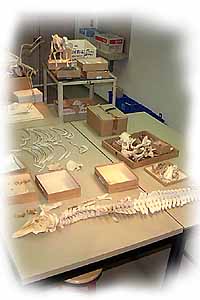1998 TOP SECRET CLUE PAGE
You might be wondering by now, why most
of the artifacts we find
during excavation are made of stone. This
is simple: stone lasts a long time!!
On the other hand, most things don't last
so long. They decay or decompose.
You probably knew this already, if you
didn't, try putting a rock on your windowsill,
beside the rock try putting an apple core.
Wait a few days, but don't wait too long
or things will start
to smell! What you are smelling is the
apple starting to decompose.
The rock, however, is still the same as
when you put it there.
This happens because rocks are inorganic
(not living) and
plants are organic (living).
Inorganic stuff takes much longer to break
down or decay then organic things.
Eventually, everything breaks down though,
even the biggest mountains will turn to sand.
In archaeology, though, we find a lot
of inorganic remains
like stone tools and stone fireplaces
(hearths) and stone benches and beds.
What we don't find a lot of is organic
stuff like food or cloth - this is because it has decomposed in the ground
way before we got there!
Lucky for us though, the speed at which
organic stuff decomposes
changes, depending on what it is and where
it is located.
Sometimes, organic material can last a
very long time,
as you may have seen in 1997's tip page
on the Ozette site
where wood was kept underwater and lasted
for a very long time.
In some circumstances even very, very
old material can be preserved.
For example, prehistoric grain is often
found carbonized (turned into charcoal)
by fire and archaeologists can identify
it thousands of years later.
Bones only last well in certain soils.
The soil here on the Northwest Coast
isn't very good for preserving bone, so
we don't find a lot of it. In Africa, though, the
sand is so dry that bones can last for
millions of years!
This is a picture of some bones in the
laboratory:
 What we do find a lot of on the Northwest
Coast of B.C. is shell. Shells make the
soil less acid and so organic stuff found
in piles of shells (called shell middens),
often preserves very well.
Dry and hot like Africa, freezing like
the Arctic and waterlogged
like at Ozette all help organic material
survive very well.
Organic material is very useful to archaeologists.
It can help us understand
what the people in the past were eating
or wearing or making as art.
In our area of the world, this is difficult
because our soils don't preserve organic
remains very well. Also, because we have
so many trees, many things like
houses and art and clothing were made
out of wood. These things usually
decompose before archaeologists ever find
them.
Oh well, we'll find other
stuff to help us do our
jobs as archaeological detectives,
right?
Right!!
TAKE
ME
What we do find a lot of on the Northwest
Coast of B.C. is shell. Shells make the
soil less acid and so organic stuff found
in piles of shells (called shell middens),
often preserves very well.
Dry and hot like Africa, freezing like
the Arctic and waterlogged
like at Ozette all help organic material
survive very well.
Organic material is very useful to archaeologists.
It can help us understand
what the people in the past were eating
or wearing or making as art.
In our area of the world, this is difficult
because our soils don't preserve organic
remains very well. Also, because we have
so many trees, many things like
houses and art and clothing were made
out of wood. These things usually
decompose before archaeologists ever find
them.
Oh well, we'll find other
stuff to help us do our
jobs as archaeological detectives,
right?
Right!!
TAKE
ME  TO
1998!
TO
1998!


